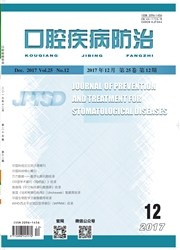

 中文摘要:
中文摘要:
目的探讨在口腔专业医护人员干预治疗下,牙科畏惧症患儿就诊次数与其畏惧程度的相关性。方法选取因牙髓炎诊治,具有明显牙科畏惧症的患儿23例;用摄像机将其每次就诊过程拍摄下来。根据Frankl量表,由同一名对治疗过程和就诊次数不知情的观察员根据录像对患儿每次就诊情况进行畏惧程度评估,间隔1周以上再次评估。比较患儿畏惧程度随就诊次数的变化。结果剔除丢失病例,最后纳入研究的患儿18例,2次评估初诊Frankl量表得分平均秩和分别为13.58、14.00,第1次复诊分别为26.44、26.33,第2次复诊分别为42.47和42.17,比较3次就诊的畏惧程度,无论是第1次评估(χ2=33.828,P=0.000)还是第2次评估(χ2=31.838,P=0.000),差异均具有统计学意义。牙科畏惧症患儿畏惧程度随就诊次数而降低,呈负相关。结论有牙科畏惧症的牙髓炎患儿通过多次就诊,增加患儿对牙科就诊的无痛体验和对常用牙科器械的熟悉,可降低其畏惧程度。
 英文摘要:
英文摘要:
Objective To study the correlation between times of return visits and the dental anxiety level in the intervention of professional dentist and nurse.Methods Twenty-three children,who came to see a doctor because of pulpitis and were suffered from serious dental anxiety,were selected in random.The whole process of the treatment was recorded with digital Cannon video camera every times till treatment was finished completely,and the dental anxiety level of each child was evaluated according to Frankl Scale by a same investigator who didn't know the treatment and treatment stage.And the results were analyzed by SPSS11.5,using Kruskal-Wallis test to study the influence of different times of return visits to children dental anxiety level.Results Eighteen cases were included in the study.The average value of Kruskal-Wallis test in two assessments for first visit were 13.58 and 14.00,for the first return visit were 26.44 and 26.33,the second return visit were 42.47 and 42.17 respectively.The difference anong the three groups was significant(P〈0.05).Conclusion It suggested that the degree of children dental anxiety could be reduced through increasing the times of return visits.
 同期刊论文项目
同期刊论文项目
 同项目期刊论文
同项目期刊论文
 期刊信息
期刊信息
